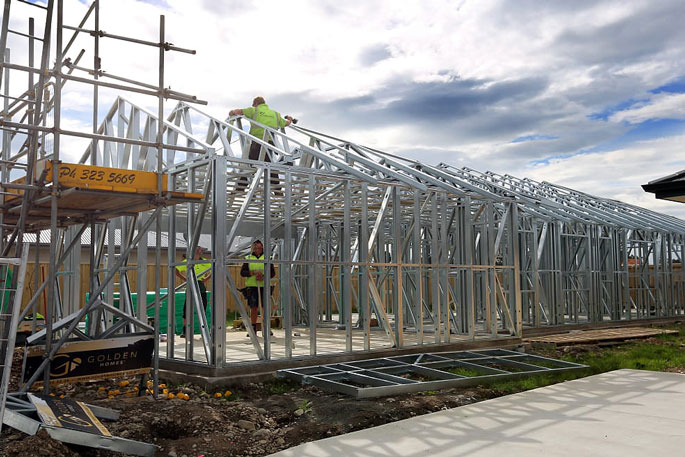A New Zealand construction supplier says the price of steel jumped 10 per cent over the weekend, following a sharp drop in the value of the New Zealand dollar.
The NZ dollar had fallen more than three per cent against the US greenback since Friday to hit 52.26 US cents - a low last seen during the March lockdown in 2020.
It was triggered by the announcement of Britain's new "mini-budget" which promises to cut taxes but increase borrowing.
The soundness of the plan upset investors, who aggressively sold out of the pound driving it to an all-time low.
The sell-down reverberated around the financial system, impacting currencies across the board, including the NZ dollar.
NZ steel supplier Tiger Saw, which imports products for the domestic market, saw the effects of the dollar's slide first hand.
Tiger Saw managing director Brent Curnow says the sharp decline has been costly for its business and its customers.
"The price went up over the weekend for steel by 10 per cent. This relates to the exchange rates for US dollars because all products that's imported for steel is purchased in US currency, so it has had a dramatic effect."
The higher costs would be passed on right throughout the building supply chain, meaning it was the end consumer who would ultimately pay, Curnow says.
The higher costs are also curbing demand for residential builds, but commercial construction activity is in a better position to withstand the price shocks, he says.
The recent sell-off in the NZ dollar against the greenback is not isolated.
Currencies around the world have been hammered this year by the aggressive tightening of monetary policy by the world's most important central bank, the US Federal Reserve.
The NZ dollar was down by about 17 per cent for the year because the higher rates available in the US, plus the safety it offers during times of global economic uncertainty, has seen the US Dollar Index - which measures the value of the greenback against a basket of currencies - hit a 20-year high.
Harbour Asset Management currency strategist Hamish Pepper says against this backdrop, the fall in the NZ dollar is not unusual.
"I think this is a reaction we are somewhat used to, where if there are worries in the world, if equity markets are falling ... we are a currency that reflects that concern."
The softness in the local currency will drive up the cost of imports, most notably fuel, Pepper says.
On the other hand, exporters will experience increased demand for their goods and services, because they will be cheaper, he says.
Bagrie Economics managing director Cameron Bagrie also predicts that New Zealand consumers will have to pay even more for goods and services that come in from overseas.
"Offshore travel is going to get progressively more expensive if you're at a US denominator destination.
"At the moment, we're screwing the scrum away from importing goods, away from domestic consumption of those imported items towards the export sector," he says, adding that farmers will be one of the sectors likely to benefit.
The tourism and export sectors will benefit from the low value dollar, Bagrie told Checkpoint.
However, Backpacker Youth Adventure Tourism Association president Brian Westwood says the weaker dollar will not necessarily entice more people to come to New Zealand, because the cost of flights is high compared with other countries.
Although, a cheaper dollar means people who are already planning to visit New Zealand have more to spend, Westwood says.
"Generally, people will have a budget in their own currency and they'll be prepared to spend a certain amount, and if that buys you more on the ground then that definitely has a benefit."
Pepper says this dynamic is the exact opposite of what the Reserve Bank is trying to achieve by raising interest rates.
"It wants to see the inflation we are inheriting from the rest of the world to be coming lower and it's wanting to see domestic economic activity slowing," he says.
"A weaker currency works against both of those things."
The Reserve Bank may have to do more in its fight against high inflation, he says.
RBNZ governor Adrian Orr says New Zealand still has more work to do to combat inflation, but it's getting there.
Inflation at 7.3 per cent is too high, but it's coming down, and New Zealand is in an "excellent" position compared with many other economies, Orr says, although he concedes that wages are being "challenged" by inflation.
"We've got a little bit more to do before we can drop to our normal happy place, which is to watch, worry and wait for signs of inflation up or down."
The RBNZ is widely expected to deliver another 50 basis points rise to take the Official Cash Rate to 3.5 per cent at its next policy meeting next week.



0 comments
Leave a Comment
You must be logged in to make a comment.